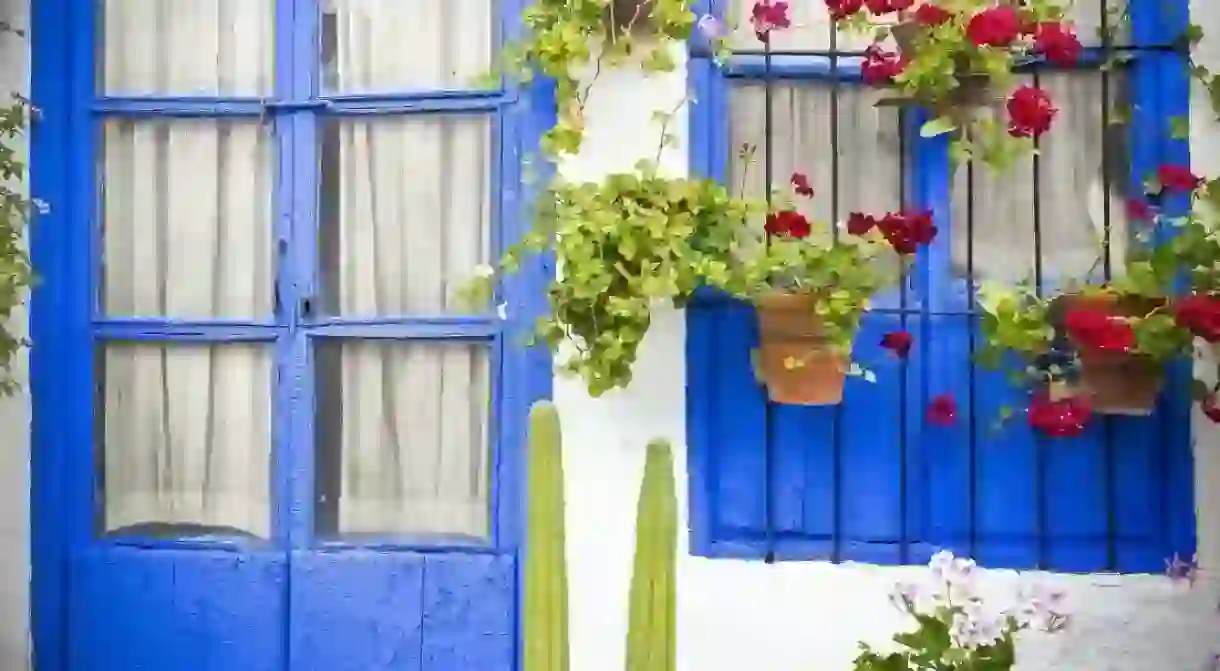How to Spend 24 Hours in Córdoba

Córdoba is perfect for those who want a city that combines the classiness of Seville with the slightly alternative feel of Granada. Home to one of the most beautiful old towns in Andalusia as well as one of Spain’s most famous historical monuments, this is a city in which a 24 hour visit will fly past.
Historic Centre
The best way to get a feel for Córdoba is to explore its beautiful historic centre, bound by the Guadalquivir river to the south and the Avenida de las Ollerias to the north. Even when compared to the oldest neighbourhoods of other major Andalusian cities, Córdoba’s is conspicuously charming, with its scrunched-together white houses decorated with pots of aromatic jasmine and geraniums. Particularly attractive in this respect is the Calleja de las Flores, a narrow, winding lane lined with what must be some of the prettiest and most colourful houses in southern Spain.
Whilst wandering, keep your eyes open for this barrio’s hidden treasures – namely, the private patios and courtyards that are opened to the public every May for the city’s enchanting Feria de los Patios. Some of these can be visited during the rest of the year, but those that are closed can still be glimpsed through closed iron gates and grilles: verdant havens of cool and calm, these lovely spaces were declared World Heritage by UNESCO in 2012.

Mosque-Cathedral
If you’re coming from the old town, the best approach to Córdoba’s star attraction is via Calle Ronda de Isasa. This busy street runs alongside the Guadalquivir river (which flows down through Andalusia and, after passing through Seville, out into the Atlantic) and is lined with sun-drenched terraces from which you can gaze out over the green, hilly countryside that surrounds the city. After a brief pitstop, it’ll be time to visit the Mosque-Cathedral – the greatest dual-identity monument in Spain.
Originally there was a Roman temple on this site, but it was replaced by a Christian church during the Visigoth era. After the Moors captured Córdoba in 711, the church was split in two and used by both Christians and Muslims as a place of worship. But the reign of religious pluralism in Córdoba didn’t last long: in 784, on the orders of the Emir Abd al-Rahman, the church was destroyed and work on a great mosque began. Construction lasted for over two centuries and, when the building was completed in 987, Córdoba’s mosque was the largest in the Islamic kingdom, save only for that of Kaaba in Arabia.

When the city was reclaimed by Christians in 1236, the mosque was converted into a church and in the 16th century Charles V added a great Renaissance nave right on top of the original Moorish structure. The mosque’s most-photographed aspect is its vast main hall, which is supported by over 850 double-arched columns. Sunlight and shadows create unusual effects as you wander among them, contemplating the multifaceted history of this great building.
Lunch in Juderia & Palacio Viana
Extending in a tangle of cobbled streets and squares to the north of the Mosque-Cathedral is Juderia, the city’s former Jewish quarter. This is a great area to stop for lunch, packed as it is with smart restaurants as well as superb no-frills tapas bars (if the latter is more your thing, Casa Pepe de la Juderia takes some beating). After a leisurely refuelling amid both locals and tourists, head back through the old town to visit another of Córdoba’s key attractions, the opulent 15th century Palacio de Viana. This vast building used to be a residence for Spanish royalty and is home to thirteen beautiful patios and gardens. Intricately designed and aromatically populated with colourful plants, flowers and trees, they are at their best during Córdoba’s Feria de los Patios in May.

Alcazar de los Reyes Cristianos
After Viana, wind up the sightseeing day in Córdoba with a visit to the Alcazar de los Reyes Cristianos (“Castle of the Christian Kings”). As its name suggests, the construction of this royal palace was ordered by the Catholic King Alfonso XI of Castile in 1328 but – as is so often the case in Andalusia – it was built amongst the ruins of a vast Moorish fort. In the late 10th century, when the Islamic Kingdom was at the height of its powers, Córdoba was the kingdom’s – and indeed one of the world’s – great intellectual cities, and the Alcazar housed the largest library in the west. Though Alfonso used only a fraction of the remains of the original Moorish structure in building the Alcazar, he chose a Mudejar style, meaning the Moorish feel of the site has been preserved.

After taking in the Alcazar, finish off your day in Córdoba as the locals do: on a warm terrace or in a noisy, heaving tapas bar for a dinner that lasts all evening. To watch the sunset over the river and the city’s famous Roman bridge, head back to the restaurants of Calle Ronda de Isasa, or if you fancy something a bit different, check out the cool bars scattered along Calle San Fernando. Córdoba combines the refined style of Seville with the bohemian ambiance of Granada, there is something here for everyone.













